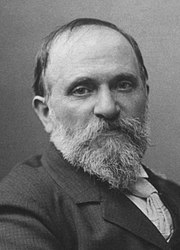Thomas Hovenden
| Thomas Hovenden | |
|---|---|

Thomas Hovenden in 1895
|
|
| Born |
December 28, 1840 Dunmanway, Co. Cork, Ireland |
| Died | August 14, 1895 (aged 54) Plymouth Meeting, Pennsylvania, United States |
| Nationality | Irish |
| Education |
Cork School of Design National Academy of Design École des Beaux Arts under Cabanel |
| Known for | Painting |
| Notable work |
The Last Moments of John Brown (1884) Breaking Home Ties (1890) |
| Spouse(s) | Helen (Corson) Hovenden |
Thomas Hovenden (December 28, 1840 – August 14, 1895), was an Irish artist and teacher. He painted realistic quiet family scenes, narrative subjects and often depicted African Americans.
Hovenden was born in Dunmanway, Co. Cork, Ireland. His parents died at the time of the potato famine and he was placed in an orphanage at the age of six. Apprenticed to a carver and gilder, he studied at the Cork School of Design.
In 1863, he immigrated to the United States. He studied at the National Academy of Design in New York City. He moved to Baltimore in 1868 and then left for Paris in 1874. He studied at the École des Beaux Arts under Cabanel, but spent most of his time with the American art colony at Pont-Aven in Brittany led by Robert Wylie, where he painted many pictures of the peasantry.
Returning to America in 1880, he became a member of the Society of American Artists and an Associate member of the National Academy of Design (elected Academician in 1882). He married Helen Corson in 1881, an artist he had met in Pont-Aven, and settled at her father's homestead in Plymouth Meeting, Pennsylvania, outside of Philadelphia. She came from a family of abolitionists and her home was a stop on the Underground Railroad. Their barn, later used as Hovenden's studio, was known as "Abolition Hall" due to its use for anti-slavery meetings.
...
Wikipedia
